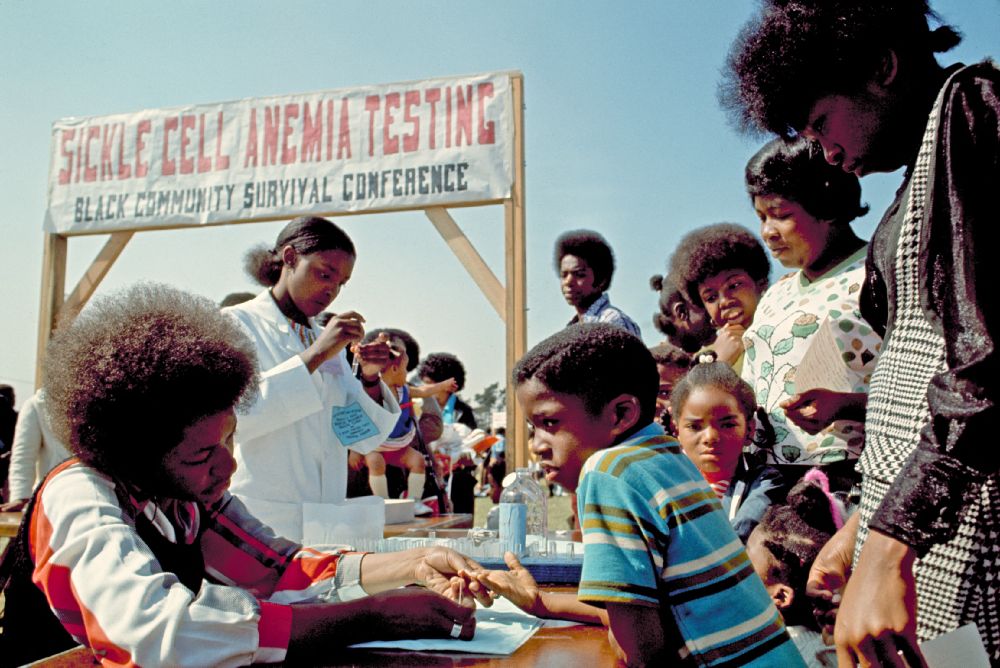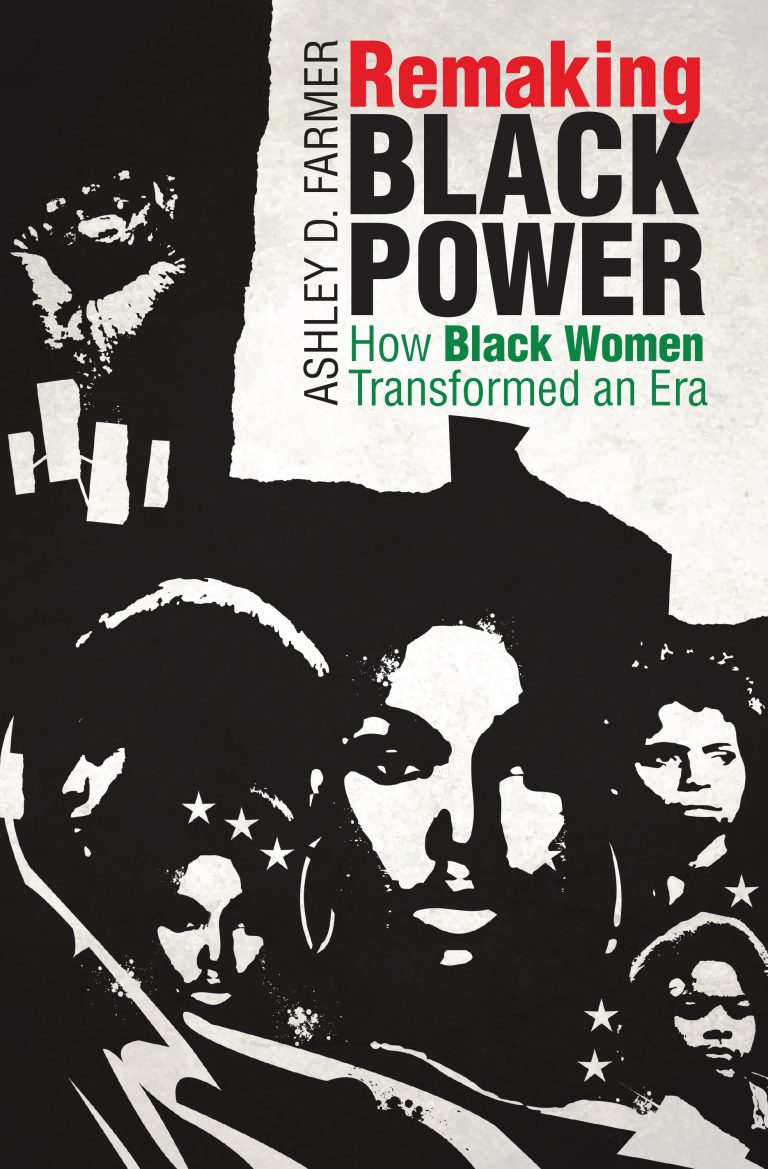The Fearless Nature of Remaking Black Power
*This post is part of our online roundtable on Ashley Farmer’s Remaking Black Power

Ashley Farmer’s comprehensive text, Remaking Black Power: How Black Women Transformed an Era, genders the Black Power movement by documenting the ideological evolution and transformation of Black womanhood from 1945 to 1979. She broadens the periodization of the Black Power era from its typical mid-1960s to mid-1970s timeline to best reflect Black women’s multiple identity politics and their relationship to modes of “‘Black Power-style radicalism’” (13). In a moment when the public is looking towards Civil Rights and Black Power women, Farmer’s work is a timely and critical monograph that explores “the alternative roles and identities that black women imagined for themselves” (18).
Powerfully written, Farmer’s major intervention rests in her exploration of women’s influence in refashioning and generating a new praxis of Black womanhood grounded in their interior lives and political trajectories. In a clever and unique way, she organizes the book chronologically by centering each of the five chapters on Black women’s leadership in the development of major tropes that shaped the period. The archetypes on “The Militant Negro Domestic,” “The Black Revolutionary Woman,” “The African Woman,” “The Pan-African Woman,” and “The Third World Black Woman” influenced the discourse and impacted the direction and operation of various Black power organizations. She posits that women “used these ideas to reshape popular perceptions of black women’s roles in political mobilization, masculinist ideas of black liberation, and the meaning of Black Power” (4). Their tremendous insight and creativity reflected their political consciousness and emancipatory visions. She explains “Black women activists’ ubiquitous engagement with redefining black womanhood illustrates the importance of not just studying what black women did but also examining who and what they aspired to do and be” (4). Rich in scholarly sources, Farmer sheds light on the endless possibilities within the interplay of “intellectual and activist work” expressed by women in their papers, writings, articles, essays, letters, questionnaires, handbooks, and artwork (15). These women demanded political autonomy, constructed new evolving theories, and in many cases pushed back against sexism and misogyny. She accounts for women’s perpetuation of patriarchal norms and points out the dominant heteronormative interpretations of the period. Brimming with self-efficacy, their viewpoints fueled internal discussions on identity politics.
Farmer’s portrait of “women’s engagement in the Black Power gendered imaginary” illuminates the functional practicality of their political theorizing (12). In doing this she engages Panther scholarship but recognizes the intersectional political perspectives of women in lesser-known organizations. In great detail she unpacks the ways Black women debated, modified, curtailed, expanded, and transformed theories of Black womanhood across organizations. These included the Communist Party, the Sojourners for Truth and Justice, the Us organization, the Committee for Unified Newark, the Black Panther Party (BPP), the Student Non-violent Coordinating Committee (SNCC), and the Third World Women’s Alliance (TWWA), among others. Reshaping the dominant discourse “in which men theorized and women organized,” Farmer teases out women’s articulations of their roles within the movement (14). Placing in one volume the experiences of women as ideologues across these different types of organizations is groundbreaking and propels the scholarship in new directions. Bravely declaring that works short on gender provide a partial fragmented analysis, she advises “attending seriously to the various ways in which black women developed gender-specific identities” (197). Farmer’s book holds currency and relevance, given the state of emergency in our country, which includes the bondage of Black and brown bodies to the carceral state, the relegation of women as second-class citizens, mass movements against sexual assault, and a host of institutional inequities. Her work offers “a framework for how black men and women might begin to dismantle their complicity in the daily reproduction of patriarchy and capitalism” (197).
Chapter two provides an organizational history of women’s involvement in the BPP in Farmer’s evaluation of gender politics. She offers a roadmap for understanding the context of the Black revolutionary woman ideal. Farmer’s assessment of the cultural labor of understudied artists including Tarika (Matailba) Lewis and M. Gayle (Asali) Dickson illustrates her best assessment of this claim. As the Panthers first woman recruit, Farmer boldly announces the intentional ways Lewis critiqued hyper-masculine overtones within the BPP and defied the “social contract that implied that black women would accept black men as the leaders and defenders of the community in exchange for protection and security” (64). In her drawings, Lewis articulates Panther politics by representing women with deep intensity as armed militants. In her images, women are portrayed as strategists in control, defending not only themselves but the men in the community. She includes women as soldiers, side-by-side with men, and directly challenges dominant perceptions of women as helpless victims lacking power, intuition, and austerity.
Dickson’s artwork represents the Panthers’s progression to inter-communalism in 1970, a theoretical organizing tool that deploys Blackness and a heightened awareness of the conditions within poor communities in the global landscape. It is rooted in the belief of borderless-ness, decolonization, and self-determination. Within inter-communalism the notion of survival is radicalized and intricately tied to revolution. Dickson captured the political ethos of the period, illustrating the practical methods the BPP served the community through social service initiatives. Women as mothers, senior citizens, and community workers served as a cardinal feature in her work. Her images infused realistic imagery, emotion, and class consciousness that demanded the humanity of working people. In her drawings the viewer is invited on a visual journey to witness the direct ways the Panthers’ practical programming curtailed the hardships of Blackness in America. She innovatively represented BPP principles in through her art, with signposts reflecting inter-communalism. Her art, for example, frequently represented the electoral campaigns of Elaine Brown and Bobby Seale and the free food program. In some of her work, she symbolized the coalition and advocacy of the Panthers within the political sphere, as illustrated by her depicitions of Shirley Chisholm running for Congress. In addition to artwork, Farmer’s analysis includes essential articles from the Panther newspaper penned by rank and file women to illustrate the gendered dialogues of the period and their impact on the organization.
In chapter five, Farmer traces the manifestation of the TWWA-championing leaders Gwen Patton and Frances Beal in providing the blueprint for the organization. She focuses on the development of the “Third World Black Woman: an activist who recognized the commonalities of oppression among women of color and the potential of a multivalent- ideological approach to eradicating them” (160). She charts TWWA’s roots in SNCC and the creation of the Black Women’s Liberation Committee (BWLC), which evolved into the Black Women’s Alliance (BLA) and finally the TWWA.
The heart of the chapter rests in her evaluation of Patton and Beale. A Detroit native, Patton began her quest for social justice as a student activist at Tuskegee University and later joined SNCC. Farmer uncovers largely unknown details that profoundly shaped Patton’s life, including the murder of her friend and comrade, Sammy Younge—a sailor in the U.S. Navy who met Patton while they were student activists at Tuskegee and in SNCC. A service station attendant murdered Younge for defying Jim Crow laws when he attempted to use a whites-only bathroom. His death impacted the political maturation of Patton and SNCC. As a response to Younge’s violence, Patton co-founded the National Black Antiwar Antidraft Union as an outlet for agitation to address the racism against Blacks in the military. Coupled with the realities of women’s marginalization in SNCC, she also co-created with Beale the BWLC. These groups allowed for women to fuse their global feminist viewpoints within a Black Power doctrine.
Farmer closely examines a questionnaire Patton constructed in preparation for BWLC’s initial meeting. Primarily, Patton’s questionnaire focused on womanhood and revolution. Responses to the questions contributed to a redefinition of the gender politics within the organization, various programming, and a name change to BLA, which mirrored their efforts to abolish imperialism and capitalism. BLA eventually cut ties with SNCC and opened up its membership. Two Puerto Rican women’s requests for memberships shifted BLA’s ideology to a more racially inclusive group and required another name change, TWWA, to reflect the diverse membership.
Farmer analyzes essays by Beal including “Slave of a Slave No More” and her classic essay, “Double Jeopardy: To Be Black and Female,” which interrogates patriarchy and the interlocking oppressions of women. In addition to discussing the plethora of political programs within the TWWA, Farmer provides golden nuggets on the organization, noting its emphasis in training its members in martial arts. Similar to the Panther chapter, she assesses articles and artwork in TWWA’s Triple Jeopardy newspaper that reified the organization’s commitment and solidarity to Third World concerns.
Perhaps more oral interviews with social activists might have strengthened Farmer’s study, but this minor concern does not reduce the merit of this essential volume. The beauty of Farmer’s work is her unapologetic nature in analyzing gender and centering the role of women across these Black Power organizations. Her study is just as fearless as the women she writes about and is critical for women’s studies, Black studies, and ethnic studies courses.
Copyright © AAIHS. May not be reprinted without permission.
